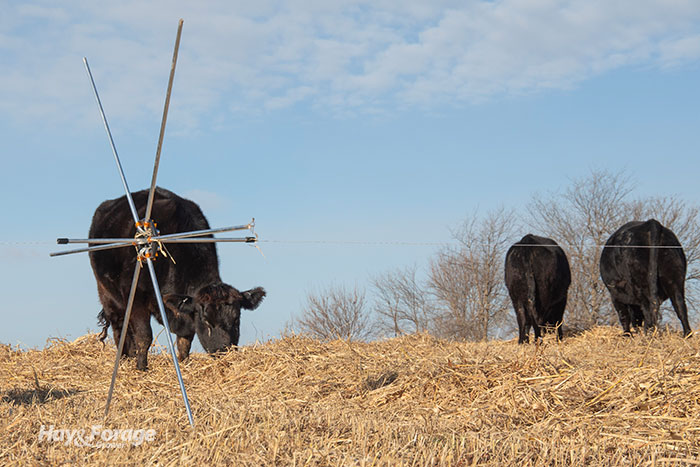Windrow grazing is more mainstream |
| By Mike Rankin, Managing Editor |
|
|
 The temperature was approaching zero, and the January wind howled from the west across the bare Iowa cropland. There I was, facing west, with camera in hand and ready for the cows to be let out to get their day’s portion of previously windrowed pearl millet forage. I pulled my heavy right-hand glove off so I could operate the camera’s shutter button. Although my fingers quickly rebelled, watching the cows devour the forage that was mowed two months earlier was astonishing and took my mind off my screaming digits. The cows acted as though they’d been turned out into a green pasture for the first time in spring. This was my first up close and personal experience with windrow or swath grazing. During winter, windrow grazing is a system that can significantly reduce harvesting and feeding costs, according to Aaron Berger. The University of Nebraska Extension beef educator notes that leaving cut swaths in the field for future grazing eliminates the cost of baling and hauling bales, reduces labor and equipment costs associated with feeding, and returns some nutrients and organic matter from consumed forage back to the soil where the crop was grown. Windrow grazing works best where winters are cold and precipitation mostly comes in the form of periodic snow. Forage quality will deteriorate more quickly with frequent rains and warmer temperatures. “Windrow grazing of warm-season annual forages such as millets, sudangrass, and sorghum-sudangrass hybrids can provide an excellent way to harvest these forages when they are at an optimum for quality and efficiently utilize them with minimal waste,” Berger explains. “Windrow grazing of cool-season annual forages such as spring triticale, oats, and spring barley planted in late summer can provide high-quality feed for late fall and winter grazing as well,” he adds. Most producers who utilize windrow grazing will plant the summer annual such that it reaches a stage of optimum yield and quality just before the first hard freeze. The crop is then left standing and mowed before the first accumulating snowfall. Leave a higher stubble to keep swaths off the ground. Windrows need to be formed as narrow and tall as possible. Berger notes that cows can easily dig through any accumulating snow to get to the windrowed forage. Windrows are best utilized when cattle are offered an area that will last one to several days. The amount of area will vary depending on available forage and the number of animals. Typically, a form of strip grazing is used with the forward temporary electric fence running perpendicular to the direction of the windrows. Frozen ground can make it difficult to pound in fence posts. Some farmers will drill pilot holes with a portable drill first. Although more expensive, tumble-wheel fences work the best in a windrow grazing system. Berger cautions that nitrate poisoning is a potential risk when warm-season annuals or small grains are used for windrow grazing. Leaving a tall stubble will help in this regard but suspect forages should be tested to avoid any negative feeding consequences. For some people, windrow grazing might seem like a far-fetched idea, but it is being used successfully on many operations to save on winter feeding costs. |
